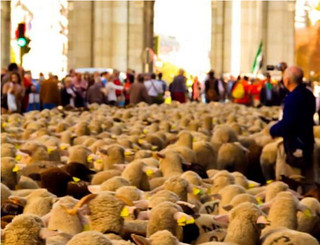
PREV ARTICLE
NEXT ARTICLE
FULL ISSUE
PREV FULL ISSUE
FLOCKS MARCH THROUGH MADRID FOR 25 MARAVEDIS
Yes, there's a numismatic connection to this article, so bear with me.
-Editor
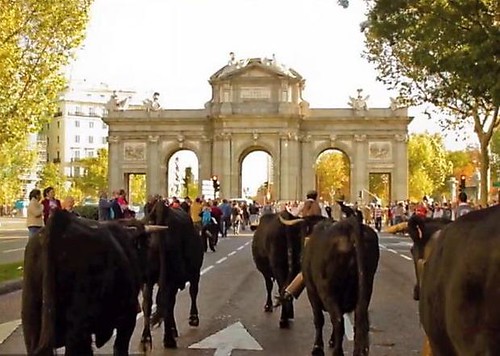
The streets of Madrid saw an entirely different protest on Sunday, as thousands of sheep and other farm animals blocked traffic in the annual "trashumancia", or transhumance event. The annual transhumance event was held, where more than 2,000 sheep and other farm stock were led through the center of the city to defend ancient grazing, droving and migration rights. This colorful event has been running every year since 1994 and is basically to defend the right to use ancient droving routes, which used to crisscross the fields and woodland, where the sprawling city of Madrid now stands. These routes have been in existence since around 1273, and the shepherds, following an age-old tradition, have to pay 25 maravedis (a type of coin first minted in the 11th century) to the city hall to use the crossing. Once this is paid, they can then take their flock through the city streets with no hindrance.
Spaniards are proud of their ancient sheep-rearing traditions. The native Marino breed is highly thought of and has been exported to South America and Australia, where they are renowned in the local wool industries.
To read the complete article, see:
I'd never heard of this event, which must be quite a spectacle to watch. But what caught my eye was the mention of the maravedis coin. I reached out to Robert Hoge, who lives part of the year in Spain to help locate images of the coin over the years. He assembled this group of images from the Classical Numismatic Group web site, and they are published here with permission. Thanks!
-Editor

1) KINGS of SPAIN, Castile. Alfonso VIII. 1158-1214. AV Dobla (Mancus) (26mm, 3.86 gm). Toledo mint. Dated Safar era 1224 (1186 AD). Pseudo-Kufic legend with cross above and ALF below, marginal legend "Struck at Toledo in 1224, Safar era" / Five line legend with star below. C&C 999; Friedberg 101. EF, light coppery toning. The gold coins struck by the early Spanish kings were intended to replace the Almoravid dinars found in wide circulation in the region. The extensive issues of Alfonso VIII of Castile were known as Moribitini or Alfonsini, elsewhere termed the mancus. Alfonso still reigned over a large Muslim population, and the types were acceptable to the merchant classes that dealt with both Muslims and Christians. Although the legends are in Arabic, the sentiments expressed are Christian, and the dates are given not in Christian AD years, but in the local Safar era, beginning in 38 BC.
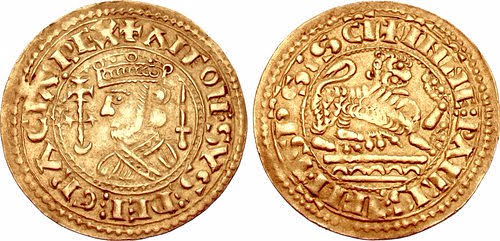
2) SPAIN, Castile & León. Alfonso IX el Baboso (the Slobberer). King of León, 1188-1230. AV Maravedi – Morabetino (27mm, 3.85 g, 6h). Salamanca mint. + ?IFONS : DEI : GR?CI? : REX (triple pellet stops), crowned bust left; before, cross-tipped scepter on crescen, flanked by stars; sword behind / + INNE : P?TRIS : IFLI : ISPS : SCI (triple pellet stops), lion rampant right. ME 1076; Friedberg 47. VF. Extremely rare. Prior to the 12th century, the majority of gold coins circulating in Christian Spain were Islamic in origin. The rulers of Léon did not strike their own gold until the reign of Fernando II, the father of Alfonso. The name of this gold coin was derived from the main source of Islamic gold: the Almoravid (Arabic al-Murabitun) kingdom of North Africa.
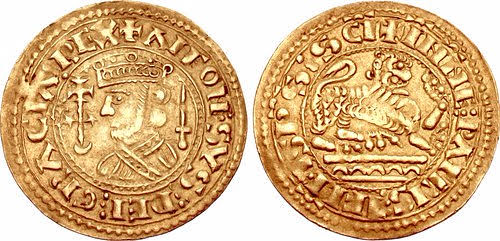
3) SPAIN. Castille and Leon. Pedro I "the Cruel."1350-1369. AV Dobla de 35 Maravedis (4.52 gm). Seville mint. +PETRVS: DEI: GRA: REX: CASTELLE: E LEGI, crowned and cuirassed bust left / +PETRVS: DEI: GRA: REX CASTELE: E LEGI:, arms of Castille and Leon. Cayon y Castan 1267 var. (legend); Burgos 326 var. (same); Heiss pg. 57, 2 var. (same). Good VF, light reverse die break. $2,750. CNR XXVII, June 2002, lot 126. Pedro I "the Cruel" was invested at age five as the king of Castille and Leon. He married the Bourbon princess Blanca, niece of Charles V of France, and had her killed eight years later at the age of 26. After several other terrible acts he was killed by his brother, Don Enrique.
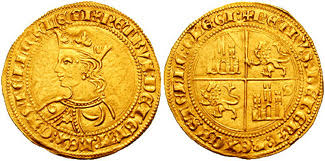
4) SPAIN, Castile & León. Pedro I el Cruel (the Cruel). 1350-1369. BI 4 Maravedís (30mm, 4.36 g, 12h). Sevilla (Seville) mint. Castle façade within polylobe / Lion rampant within polylobe. ME 1297. Near VF.
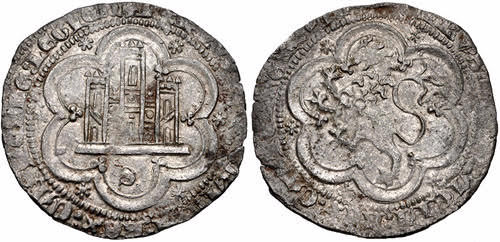
5) SPAIN, Castile & León. Fernando V & Isabel I (Los Reyes Católicos - the Catholic royals). 1474-1504. CU 2 Maravedis (26mm, 4.36 g, 12h). Cuenca mint. Three-towered castle façade; patriarchal cross and C flanking; pomegranate in exergue / Crowned lion passant left. Cf. ME 24579; cf. MEC 6, 846 (both refs for type). VF, dark brown patina, hint of weak strike at center.
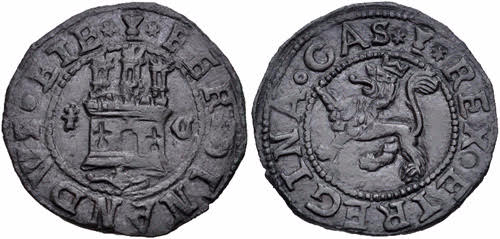
6) SPAIN, Reino de España. Felipe IV el Grande. 1621-1665. Æ 8 Maravedis (27mm, 5.54 g, 12h). Segovia mint. Dated 1623. Crowned arms of Castile / Crowned arms of Leon. ME 5413; KM 10.6. EF, brown surfaces.
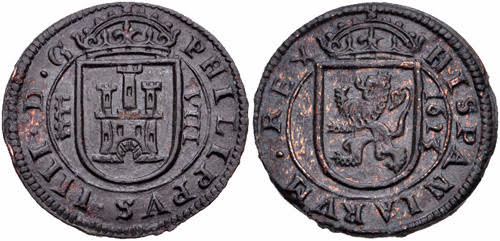
7) SPAIN, Reino de España. Carlos III. 1759-1788. Æ Maravedí (15mm, 1.48 g, 12h). Segovia mint. Dated 1772. Garlanded head right / Coat-of-arms within wreath. ME 10930; Calicó 1926; KM 405.2. Choice EF, red-brown surfaces.
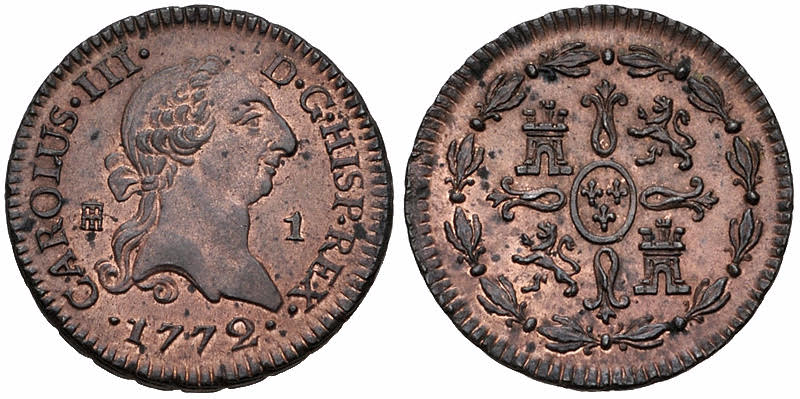
8) SPAIN, Reino de España. Isabel II. 1833-1868. CU 4 Maravedi (24mm, 5.14 g, 12h). Jubia mint. 1847 JA. ME 16646; KM 530.2. UNC, red and brown surfaces, minor spotting. From the HLT Collection.
To visit the CNG web site see:
Robert adds these comments for background on the unusual event. Thank you!
-Editor
The strange annual transhumance occurrence in Spain is referred to as the cañada ("passage") of the livestock whose proprietors, originally small-holders but later principally nobles and the church, were called the Mesta ("Mixed") meaning free-ranging animals (sheep), whose right-of-way, by the hundreds of thousands, landowners (read poor farmers!) were forbidden to block. The favoritism given to this element of society contributed mightily to the backwardness and economic devastation of Spain in the late Middle Ages and early modern period -- part of the anti-progressive elements that contributed to the Spanish Empire's downfall. One of my old professors waxed on about this phenomenon, and I have always remembered and marveled over it! I didn't realize, though, that it is still going on in at least some small way (it was supposedly "abolished" in the 1830s, I have read). I guess we can think of this as the first cattlemen's association (cattle in the form of its origin, as "chattel"), and as the practice that eventually gave rise to the famous cattle drives of the American West. 
Wayne Homren, Editor The Numismatic Bibliomania Society is a non-profit organization promoting numismatic literature. See our web site at coinbooks.org. To submit items for publication in The E-Sylum, write to the Editor at this address: whomren@gmail.com To subscribe go to: https://my.binhost.com/lists/listinfo/esylum All Rights Reserved. NBS Home Page Contact the NBS webmaster 
|
